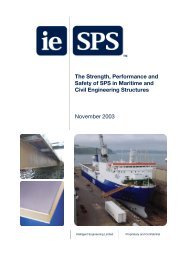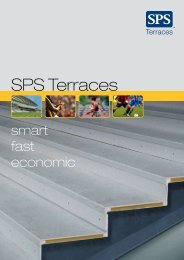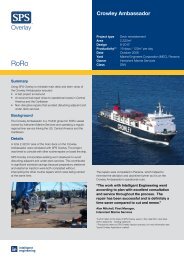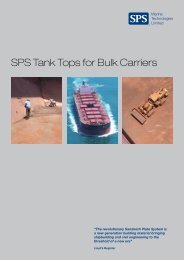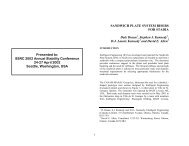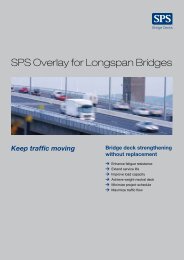The Performance, Safety and Production Benefits of SPS Structures ...
The Performance, Safety and Production Benefits of SPS Structures ...
The Performance, Safety and Production Benefits of SPS Structures ...
You also want an ePaper? Increase the reach of your titles
YUMPU automatically turns print PDFs into web optimized ePapers that Google loves.
Lloyd’s Register, together with the University <strong>of</strong>Strathclyde, are conducting a series <strong>of</strong> Fire EngineeringAnalyses for a number <strong>of</strong> <strong>SPS</strong> designs in accordancewith recently introduced IMO guidelines (SOLASChapter II-2 Regulation 17). Based on the analysis <strong>of</strong> theDFDS Tor Line funnel casing constructed withprefabricated <strong>SPS</strong> plates, Lloyd’s Register presented thefollowing conclusion in the submission, which wassubmitted to the Danish Maritime Authority <strong>and</strong> is nowapproved.“From review <strong>of</strong> the extensive research <strong>and</strong> development<strong>and</strong> the fire engineering analysis carried out byIntelligent Engineering Limited <strong>and</strong> StrathclydeUniversity, some <strong>of</strong> which is reproduced in this report, itis concluded that for its intended use, <strong>SPS</strong> meets all therelevant safety objectives <strong>and</strong> functional requirements <strong>of</strong>the revised SOLAS Chapter II-2 <strong>and</strong> should beconsidered as at least equivalent to a conventionalinsulated stiffened steel plate <strong>of</strong> A-60 fire rating.”ENERGY ABSORPTIONTo increase its energy absorption capacity, a structuremust be simplified <strong>and</strong> designed to allow localizedprogressive plastic membrane action in the hull or sideshell plating to occur. Simplification is achieved byeliminating stiffeners <strong>and</strong> by introducing a plate structurewith equivalent in-plane buckling capacity <strong>and</strong> stiffnessto the stiffened plate, <strong>and</strong> flexural capacity to sustaintransverse loads. This is uniquely achieved with the <strong>SPS</strong>plate section. Furthermore, the ductile core eliminateshard spots over primary supports <strong>and</strong> providescontinuous support to the face plates, dissipatinglocalized bending strains. <strong>The</strong> net effect is an increase tothe puncture resistance <strong>and</strong> blast resistance. A furtherbenefit is that the polyurethane elastomer provides aneffective crack arrest layer. In the case <strong>of</strong> double hullproduct oil tankers, the inner cargo tank lining can beeffectively isolated from cracks that propagate from tears(sheared plating which may eventually occur under highenergy impacts) in the outer hull through the framingmembers into the inner hull, thus preventing oil outflow.Figures A.4(a) <strong>and</strong> (b) graphically illustrate the localimpact resistance <strong>of</strong> a stiffened steel plate <strong>and</strong> a <strong>SPS</strong>plate when subjected to a corner shaped impactor,simulating the impacts <strong>of</strong> ship hulls with floating semisubmergedcontainers or dead heads or grazing <strong>of</strong>fwharfs or from grabs for tank tops in bulk carriers. <strong>The</strong>impactor was mounted on a pendulum swing with a mass<strong>of</strong> 2 tonnes that was raised two metres <strong>and</strong> released. <strong>The</strong>impactor struck the plate at approximately 20 km/hr.<strong>The</strong> stiffeners <strong>of</strong> the steel plate were buckled where theyframed into transverses <strong>and</strong> the plating was holed orpunctured. <strong>The</strong> impacted faceplate <strong>of</strong> the <strong>SPS</strong> plate wasplastically deformed in the shape <strong>of</strong> the impactor <strong>and</strong>embedded into the elastomer core in the shape, but notpenetrated.Figure A.4(c) shows a plastically deformed stiffenedsteel plate icebreaker hull section. At the load points thehull plating was bent sharply (hard spot withconcentrated bending strains) <strong>and</strong> ruptured. FigureA.4(d) shows the outer hull <strong>of</strong> a 40,000 dwt <strong>SPS</strong> productoil tanker loaded with four 500T actuators. <strong>The</strong> hullplates, <strong>and</strong> longitudinal <strong>and</strong> transverse girders, weredesigned for both normal operating loads <strong>and</strong> tomaximize the energy absorption capacity for extremeloads events. <strong>The</strong> hull plating developed plasticmembrane action between longitudinal girders, whichextended into adjacent cells as the longitudinal buckled.Rupture <strong>of</strong> the outer <strong>SPS</strong> plating did not occur as theelastomer core effectively distributed the load <strong>and</strong>dissipated the bending strains.Figures A.4(e) <strong>and</strong> (f) show a stiffened steel hull sectionthat was subject to a terrorist bomb attack <strong>and</strong> twostructurally equivalent plates that were subjected tounderwater blast loads. In both cases the steel platesshear, tear <strong>and</strong> open. Not only is the hull ruptured butalso a significant portion <strong>of</strong> the blast energy wastransmitted to the structure or contents behind the hullplate causing secondary damage. <strong>The</strong> <strong>SPS</strong> plateeffectively contained the blast load through plasticmembrane action.<strong>The</strong> use <strong>of</strong> <strong>SPS</strong> plates coupled with the appropriateenergy absorption design philosophy improves the crashworthiness <strong>of</strong> the hull structure (maximizes the totalenergy absorption <strong>of</strong> the structure), provides a decreasedrisk <strong>of</strong> environmental pollution <strong>and</strong> asset protection.LATEST DEVELOPMENT PROGRAMMEIn addition to the programmes described above, IEcontinues to develop <strong>SPS</strong> technology. <strong>The</strong> objectives <strong>of</strong>the development are to improve underst<strong>and</strong>ing <strong>of</strong> thecharacteristics <strong>and</strong> capabilities <strong>of</strong> the technology, todevelop design methodologies <strong>and</strong> to test the suitabilityfor new applications.Among the latest developments are:• Ongoing classification approvals for specificapplications: <strong>The</strong>se have been achieved with sixmajor classification societies.• General material type approval for the elastomercore: This has been granted by DNV <strong>and</strong> similarapprovals are being pursued with the others societies.• A programme to establish a set <strong>of</strong> ship designverification rules: Lloyd’s Register is developing aset <strong>of</strong> rules <strong>and</strong> procedures for design assessment <strong>of</strong>ship structures using steel composite construction.This will enable designers to work towards anestablished st<strong>and</strong>ard for strength.• Investigation <strong>and</strong> full scale testing <strong>of</strong> <strong>SPS</strong>performance in ship collisions <strong>and</strong> grounding: Thiswork will compare the performance <strong>of</strong> <strong>SPS</strong> <strong>and</strong> all-17



